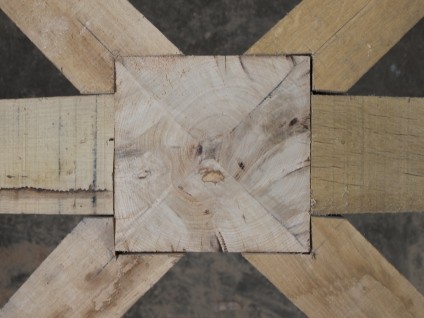EMBODIED ENERGY OF STEEL IN POST-AND-BEAM FRAMES
A short while ago I was comparing different frame construction methods for a project I was working on and was reminded how big the difference in embodied energy is between a “timber only” frame (traditional pegged joinery) or a “timber and steel" frame which utilizes steel connectors (often called timber engineering).
A trawl of the internet for the latest embodied energy values and a quick application of these to a fictitious timber beam suggests, as the calculation for the whole frame did, that a post and beam frame with steel flitch connectors at the joints can have an embodied energy in the region of 25 times higher than it's traditional cousin!
This has got to be interesting to anybody who aspires to design very low impact projects, especially these days with the balance between energy consumed “in use” and embodied energy changing so drastically, as the “in use” energy consumption moves towards zero (for the theoretical space heating at least). Over the years I have built many frames that relied on steel connectors for stability where there could have been “traditional all timber” solutions or “part steel part traditional” solutions which would have much better realized the designers and clients vision of a truly low impact building. So I thought I would set down on this page the “back of a fag packet” calculation mentioned above, to compare the two types of framing and show how much the steel can add to the buildings carbon footprint.
I should point out first that embodied energy is a very complicated and imprecise area at the best of times with values varying sometimes by quite big margins, and my own calculation is even more so due to the fact that there are so many variables (a “timber only” frame might need more bracing for example), I'm choosing a design specification amongst many (dimensions etc.) and I unfortunately don't have the time to do anything but a cursory survey and rough working. I also don't have access to any of the new software tools (rather expensive) which are probably much more up to date. In any case I've tried to choose as typical an example and specification as possible, but even if I'm a bit off-the-mark the results are quite striking, and should, I think, give any designer food for thought.
This is all very slapdash I realize but it's only intended as a rough overview of the situation, so please bear with me.
I've put the embodied energy values I got from the internet at the bottom of the page.
So here is how I got to the 25 times figure:
For the purposes of this exercise I assumed an oak beam 200x300x4m which could be part of a typical portal frame, either with or without steel flitches and shoes joining the members. There should be a steel tie rod across the middle of such a frame but I have disregarded this in the calculation as it would apply in both versions (although of course it could be replaced with a wooden tie beam in another scenario).
Although the timber usually utilized in both traditional and steel jointed frames is green (unseasoned) there are no values available for this, so I have used values for air dried hardwood which should be almost exactly the same as for green, since there is no energy consumption in air drying a stack of wood.
I've assumed stainless steel as this is most often specified in my experience, sometimes for aesthetic reasons, sometimes through necessity, but using galvanized mild steel would reduce the embodied energy of this element quite a bit. I have only included in the calculation the half of each steel flitch (and its attendant pins or bolts) which belongs to the beam. The dimensions of the steelwork are fairly typical (although they could probably be reduced) and I have known much bigger. On the Loch Lomond and Trossachs National Park Headquarters, which I worked on when employed by Carpenter Oak and Woodland, some of the flitches were so heavy it took six people to carry them and they had an absolute myriad of bolts in them. It was a very big frame though with much bigger timbers than this example.
Beam with traditional joinery:
Oak beam 200mm x 300mm x 4m = 0.24 cubic m
= 180Kg x 0.5MJ
= 90MJ embodied energy
Beam with S/Steel joinery:
S/Steel flitches (halves belonging to beam) 12mm x 275mm x 450mm x 2no. = 0.0029 cubic m
S/Steel pins (six each end) 25mm x 350mm x 12no. = 0.002 cubic m
total cube = 0.00496
= 38.94Kg x 56.7MJ (conservative value)
=2208MJ embodied energy
add the 90MJ for the timber = 2298MJ total embodied energy
2298/90 = 25.5 So the steel joinery increases the embodied energy of the beam by 2550% or more than 25 times.
And finally the embodied energy values I collected for steel and wood (and some other materials for comparison in square brackets):
Plymouth University “Composites design and manufacture”:
air dried sawn hardwood 0.5MJ/Kg (used in calculation)
stainless steel 110MJ/Kg
[ steel (virgin not galv.) 32MJ/Kg ]
[ glulam 4.6MJ/Kg ]
University of Bath “inventory of carbon and energy” 2011 (only covers cradle to gate)
[ sawn hardwood (kiln dried) 7.4MJ/Kg (conventionally powered kilning accounts for 80–90% of emb. energy in kiln dried wood so 1.11MJ/Kg for green or AD?) ]
stainless steel 56.7MJ/Kg (used in calculation)
[ steel sheet galvanized 39MJ/Kg ]
[ straw 0.24MJ/Kg ]
[ rammed earth 0.45MJ/Kg]
Australian Government “your home” web page
air dried sawn hardwood 0.5MJ/Kg
[ galvanized steel 38MJ/Kg ]
University of Wellington (NZ) School of Architecture website
air dried roughsawn hardwood 0.5MJ/Kg

J. Rose Carpentry